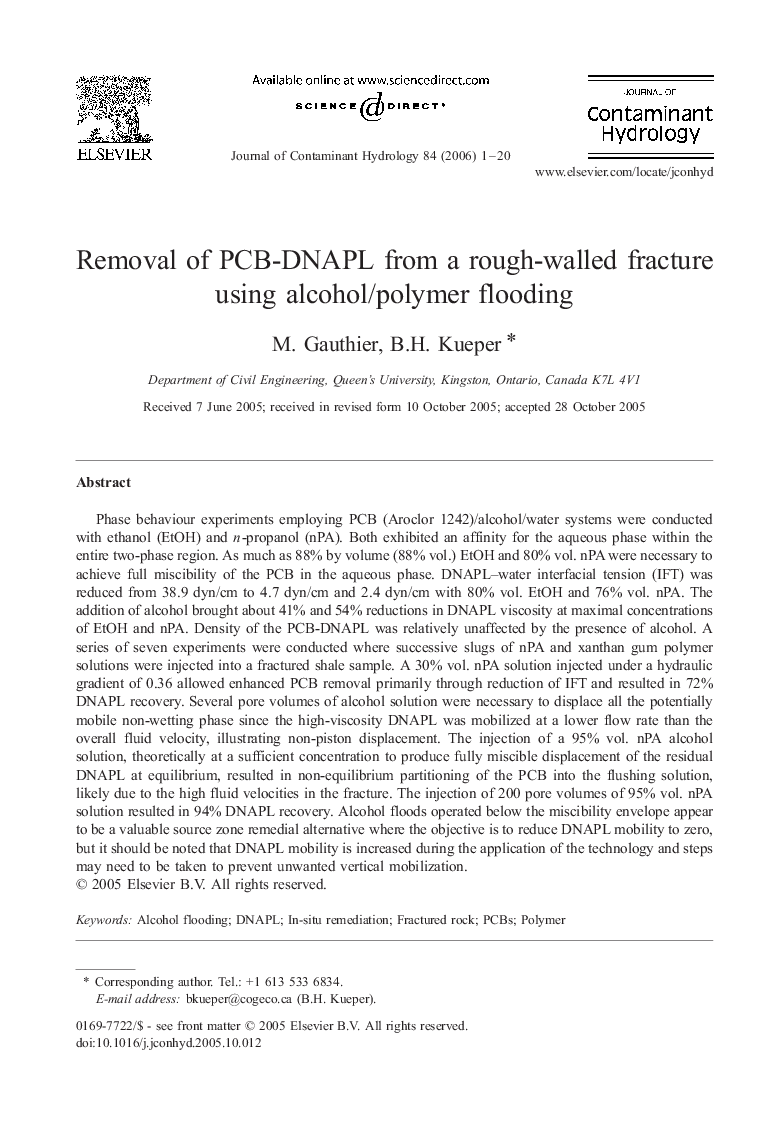| کد مقاله | کد نشریه | سال انتشار | مقاله انگلیسی | نسخه تمام متن |
|---|---|---|---|---|
| 4547734 | 1627139 | 2006 | 20 صفحه PDF | دانلود رایگان |

Phase behaviour experiments employing PCB (Aroclor 1242)/alcohol/water systems were conducted with ethanol (EtOH) and n-propanol (nPA). Both exhibited an affinity for the aqueous phase within the entire two-phase region. As much as 88% by volume (88% vol.) EtOH and 80% vol. nPA were necessary to achieve full miscibility of the PCB in the aqueous phase. DNAPL–water interfacial tension (IFT) was reduced from 38.9 dyn/cm to 4.7 dyn/cm and 2.4 dyn/cm with 80% vol. EtOH and 76% vol. nPA. The addition of alcohol brought about 41% and 54% reductions in DNAPL viscosity at maximal concentrations of EtOH and nPA. Density of the PCB-DNAPL was relatively unaffected by the presence of alcohol. A series of seven experiments were conducted where successive slugs of nPA and xanthan gum polymer solutions were injected into a fractured shale sample. A 30% vol. nPA solution injected under a hydraulic gradient of 0.36 allowed enhanced PCB removal primarily through reduction of IFT and resulted in 72% DNAPL recovery. Several pore volumes of alcohol solution were necessary to displace all the potentially mobile non-wetting phase since the high-viscosity DNAPL was mobilized at a lower flow rate than the overall fluid velocity, illustrating non-piston displacement. The injection of a 95% vol. nPA alcohol solution, theoretically at a sufficient concentration to produce fully miscible displacement of the residual DNAPL at equilibrium, resulted in non-equilibrium partitioning of the PCB into the flushing solution, likely due to the high fluid velocities in the fracture. The injection of 200 pore volumes of 95% vol. nPA solution resulted in 94% DNAPL recovery. Alcohol floods operated below the miscibility envelope appear to be a valuable source zone remedial alternative where the objective is to reduce DNAPL mobility to zero, but it should be noted that DNAPL mobility is increased during the application of the technology and steps may need to be taken to prevent unwanted vertical mobilization.
Journal: Journal of Contaminant Hydrology - Volume 84, Issues 1–2, 1 March 2006, Pages 1–20